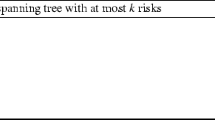Abstract
In telecommunication networks based on the current Ethernet technology, routing of traffic demands is based on multiple spanning trees: the network operator configures different routing spanning trees and assigns each demand to be routed in one of the selected spanning trees. A major optimization issue in this solution is the combined determination of (i) a set of appropriate spanning trees, and (ii) assignment of demands to the trees, in order to achieve an optimal load balancing on the links of the network. In this paper we consider models and solving techniques for lexicographical optimization of two load balancing objective functions. The first objective is the min-max optimization of the n worst link loads (with n up to the total number of network links), and the second objective is the minimization of the average link load (when n is smaller than the total number of network links). Besides exact methods, a heuristic technique that can compute both feasible solutions and lower bounds for the addressed optimization problem is proposed. Finally, we discuss effectiveness of different solution using results of a numerical study of realistic case studies.
Similar content being viewed by others
References
IEEE Standard 802.1s (2002). Virtual bridged local area networks—Amendment 3: multiple spanning trees.
Technical Specification MEF 6.1, (2008). Ethernet services definitions—Phase 2, Metro Ethernet Forum.
de Sousa, A. F., & Soares, G. (2007). Improving load balance and minimizing service disruption on ethernet networks using IEEE 802.1S MSTP. In EuroFGI workshop on IP QoS and traffic control (pp. 25–35). Paris: IST.
Iovanna, P., Nicosia, G., Oriolo, G., Sanita, L., & Sperduto, E. (2008). Local restoration for trees and arborescences. In Lecture notes on computer science : Vol. 5464. First Euro-NF workshop, FITraMEn 2008, Revised selected papers (pp. 130–140). Berlin: Springer.
Padmaraj, M., Nair, S., Marchetti, M., Chiruvolu, G., & Ali, M. (2005). Traffic engineering in enterprise ethernet with multiple spanning tree regions. In Proc. of system communications (ICW’05), Montreal, Canada (pp. 261–266).
de Sousa, A. F., & Soares, G. (2006). Improving load balance of ethernet carrier networks using IEEE 802.1S MSTP with multiple regions. In Lecture notes on computer science : Vol. 3976. IFIP TC6 networking (pp. 1250–1260). Berlin: Springer.
Kern, A., Moldovan, I., & Cinkler, T. (2006). Scalable tree optimization for QoS ethernet. In IEEE symp. on computers and communications (ISCC’06) (pp. 578–584).
Ali, M., Chiruvolu, G., & Ge, A. (2005). Traffic engineering in metro ethernet. IEEE Network, 19(2), 10–17.
Kolarov, A., Sengupta, B., & Iwata, A. (2004). Design of multiple reverse spanning trees in next generation of ethernet-VPNs. In IEEE GLOBECOM’04 (Vol. 3, pp. 1390–1395).
Sharma, S., Gopalan, K., Nanda, S., & Chiueh, T. (2004). Viking: a multi-spanning-tree ethernet architecture for metropolitan area and cluster networks. In IEEE INFOCOM’04 (Vol. 4, pp. 2283–2294).
Ishizu, K., Kuroda, M., & Kamura, K. (2004). SSTP: an 802.1s extention to support scalable spanning tree for mobile metropolitan area network. In IEEE GLOBECOM’04 (Vol. 3, pp. 1500–1504).
Lim, Y., Yu, H., Das, S., Lee, S.-S., & Gerla, M. (2003). QoS-aware multiple spanning tree mechanism over a bridged LAN environment. In IEEE GLOBECOM’03 (Vol. 6, pp. 3068–3072).
Santos, D., de Sousa, A., & Alvelos, F. (2008). Traffic engineering of telecommunication networks based on multiple spanning tree routing. In Lecture notes on computer science : Vol. 5464. First Euro-NF workshop, FITraMEn 2008, Revised selected papers (pp. 114–129). Berlin: Springer.
Santos, D., de Sousa, A., & Alvelos, F. (2009). Load balancing of telecommunication networks based on multiple spanning trees. In International network optimization conference (INOC), Pisa, Italy.
Pióro, M., & Medhi, D. (2004). Routing, flow and capacity design in communication and computer networks. San Mateo: Morgan Kaufmann.
Ogryczak, W., Pióro, M., & Tomaszewski, A. (2005). Telecommunications network design and max-min optimization problem. Journal of Telecommunications and Information Technology, 3, 43–56.
Nace, D., & Pióro, M. (2008). Max-Min fairness and its applications to routing and load-balancing in communication networks: a tutorial. IEEE Surveys and Tutorials, 10(4), 5–17.
Radunovic, B., & Boudec, J.-Y. L. (2007). A unified framework for max-min and min-max fairness with applications. ACM/IEEE Transactions on Networking, 15(5), 1073–1083.
Dzida, M., Pióro, M., & Zagożdżon, M. (2004). The application of max-min fairness rule to bandwidth allocation in telecommunication networks. In The 3rd Polish-German teletraffic symposium (PGTS), Dresden.
Pióro, M., Dzida, M., Kubilinskas, E., Nilsson, P., Ogryczak, W., Tomaszewski, A., & Zagożdżon, M. (2005). Applications of the max-min fairness principle in telecommunication network design. In Next generation Internet networks (NGI 05), IEEE Xplore, Rome, Italy.
Ogryczak, W., Milewski, M., & Wierzbicki, A. (2007). Fair and effcient bandwidth allocation with the reference point methodology. In International network optimization conference (INOC), Spa, Belgium.
Ogryczak, W., & Śliwiński, T. (2003). On solving linear programs with the ordered weighted averaging objective. European Journal of Operational Research, 148, 80–91.
Santos, D., de Sousa, A., Alvelos, F., Dzida, M., Pióro, M., & Zagożdżdon, M. (2009). Traffic engineering of multiple spanning tree routing networks: the load balancing case. In Next generation Internet networks (NGI 09), IEEE Xplore, Aveiro, Portugal.
Author information
Authors and Affiliations
Corresponding author
Rights and permissions
About this article
Cite this article
Santos, D., de Sousa, A., Alvelos, F. et al. Optimization of link load balancing in multiple spanning tree routing networks. Telecommun Syst 48, 109–124 (2011). https://doi.org/10.1007/s11235-010-9337-8
Published:
Issue Date:
DOI: https://doi.org/10.1007/s11235-010-9337-8




